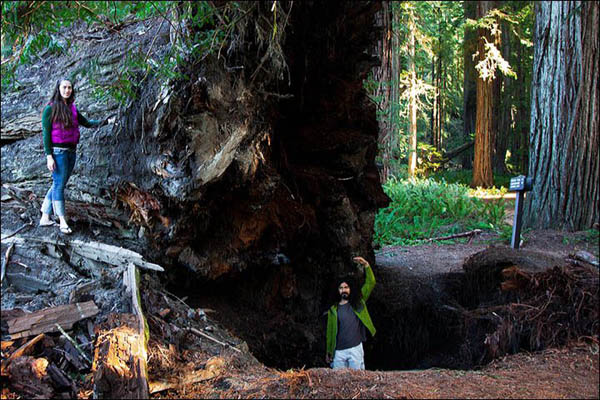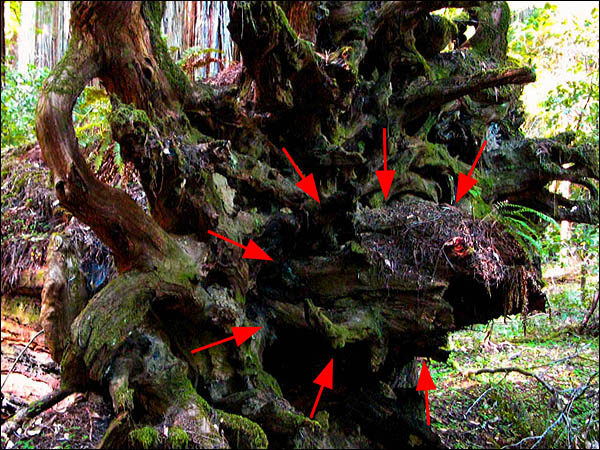The question could be “is Stout Grove as you knew it, perishing?
The big redwood which fell around 2013 – 2014 in Stout Grove, was an interesting revelation. It opened a 7 ft. deep pit, a hidden chapter from the past. For me at least, that’s a testimonial from the grove that this redwood’s origin was 7 feet below the surface. Hundreds of years ago, maybe even a millennium, a tiny seed germinated at the bottom of that pit when that used to be the surface of the forest floor.
And now its evident that this redwood was not flourishing, but surviving as layer upon layer of sediment covered the original root system. Actually, before some branch debris was thrown in the hole, more wood in the center at the bottom was evident, and it seemed more like a buried trunk remnant than an old root. I think the tree’s origin was more like 8 ft. to 10 ft. below the soil level we see now.
Here is a photo of the fallen redwood in Stout Grove
The sediments probably came from the Smith River or Mill Creek, although some could wash down the hill from the parking lot side of the grove. I would bet on the Smith River though.
It must take one hell of a flood to reach the grove’s interior and build up the soil depth. On the other hand, the higher the soil level, the less often the river will reach the interior, because each deposit of soil depth would require a higher flood to breach the surface.
So now the story unfolds. The grade used to lower, and a the river could flood it more often. The redwoods were smaller, younger and maybe more vigorous; roots not buried under tons of soil.
Here is another example from Bull Creek Flats. In this case, the old trunk buried by sediment is in the middle, protruding out the bottom. After it was partially buried, the redwood grew more roots and the trunk enlarged for however long it survived; probably several centuries at least.
As I watch redwoods fall in Stout Grove, or break like the huge chunk that fell from Stout Tree, there is something else I have trouble finding there … and that is coast redwood seedlings.
If a grove loses 10 redwoods in 10 years (for example), but only one redwood germinates, the grove is perishing, at least for a stand of redwoods.
I came to the realization that some great redwood groves that we enjoy so much, may change in our generation or the next few generations. Is Stout Grove perishing? Probably, but maybe just from man’s point of view. Is that a problem? Not if you don’t get too sentimental and understand that the redwood forest is continually changing. The redwoods live long and the change may happen gradually enough that its easy to ignore even if if some change does happen during our life span.
In 200 years, if half of Stout Grove blows down or gets buried in more sediment, surely some other grove will grow and take it’s place.



Recent Comments